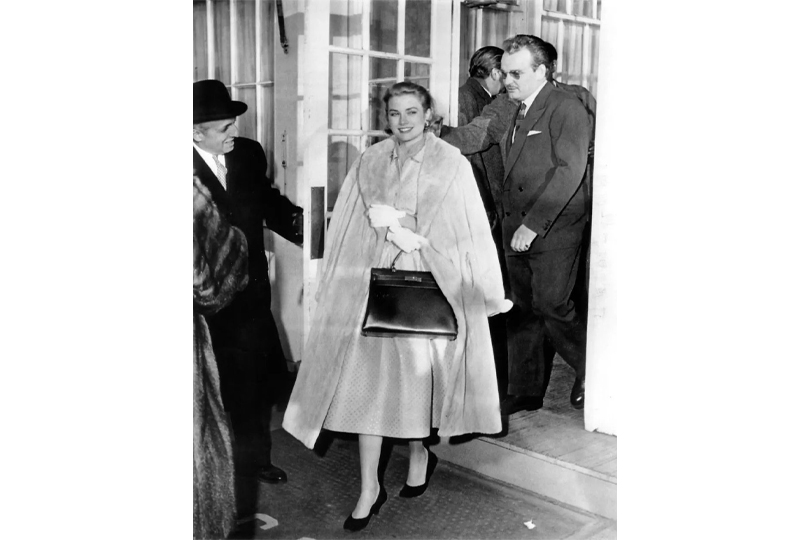Part of an ongoing series of 29Secrets stories, taking a deep dive into the history of legendary beauty products and iconic fashion moments…
By Christopher Turner
Illustration by Michael Hak
It was the original “It” bag. The Hermès Kelly bag isn’t the only highly coveted style from the legendary French fashion house, but it does have a long and storied history filled with glamour and royalty. Unlike the iconic Birkin bag, which was simultaneously created and named in honour of actor, model and muse Jane Birkin, the Kelly bag was originally named the Sac à Dépêches. Created in the 1930s, it was redesigned several times before it was popularized by and then renamed after Hollywood star turned Princess of Monaco, Grace Kelly.
The story goes that in the 1950s, costume designer Edith Head chose Hermès accessories with which to style Kelly, the leading lady in To Catch a Thief. Kelly loved the Sac à Dépêches handbag so much that she continued to wear it off set, even using it to conceal the early signs of her first pregnancy in 1956. The photos went around the world and made the (then relatively unknown) bag famous – though it would be another two decades before it was officially renamed ‘Kelly’ by Hermès, in 1977.
Of course, that’s not the entire story of the quintessential fashion accessory. Here’s the full story of the bag’s original creation, the redesigns, and how an award-winning costumer, the legendary master of suspense, and of course a fashion icon changed the destiny of Hermès and their chic Sac à Dépêches leather handbag.
The history of Hermès
First, a little history on the family-owned French fashion house. In 1837, Thierry Hermès founded his eponymous business in Paris as a horse harness shop, dedicated to serving European noblemen. Winning various awards during the late 1800s, Hermès (pronounced air-MEZ) earned a reputation as one the finest producers of leather goods for horses – crafting all things equestrian, from saddles to bags, boots to hats. His son Charles-Émile later moved the Hermès flagship shop to 24 rue du Faubourg Saint-Honoré in the heart of Paris in 1880, where it remains to this day.
By the 1900s, under the founder’s grandson Émile-Maurice, Hermès became the official saddler for the Czar of Russia, and the first brand to introduce the zipper on leather goods in France. The brand’s foray into leather handbags slowly followed, along with an expansion into haute couture, jewellery, watches, porcelain goods and silk scarves.
The Sac à Dépêches
In 1892, Hermès released the Haut à courroies, their first-ever bag, which would set the path for all other bags to come. However, the Haut à courroies wasn’t a handbag: it was a large leather bag designed to carry a saddle, riding boots and other essential equestrian gear. Still, you can see the early seeds of both the Kelly and the Birkin bags in this original style: the signature flap that secures over the single rolled handle, leather straps and a metal plaque were all a part of the original design of the over-sized Haut à courroies.
In 1928, Robert Dumas (who would eventually take over from his father-in-law as the chairman of Hermès in 1951) reimagined the Haut à courroies as a smaller, more elegant bag that could be used for carrying papers and files; he named it the Sac à Dépêches, or “dispatch bag.” With its strong trapezoid shape, rigid structure and top handle, the Sac à Dépêches was a significant departure from the popular bags of the time, which were all much smaller, resembling an envelope. The unusual Hermès style was quickly adopted by the fashionable women of the day, while an even larger Sac à Dépêches was carried by prominent men around the globe, including John F. Kennedy and the Duke of Windsor, as a briefcase.
The Sac à Dépêches was popular and can be considered one of the first true handbags; however, it wouldn’t reach its “It” bag status for several decades. In the meantime, it was redesigned several times to become stiffer and boxier, but still retaining the appeal of its original intent among the elite.
To Catch a Thief
Filmmaker Alfred Hitchcock paid $15,000 to purchase the rights to David Dodge’s 1952 novel, To Catch a Thief, almost immediately after it was published; however, filming the adaptation of the bestselling thriller didn’t start until the spring of 1954. During the years in between, the script was developed, and Hitchcock spent his time convincing Cary Grant to ditch his plans to retire from acting so he could star in the film as the retired jewel thief John Robie (“The Cat”), as well as offering Kelly the role of Frances Stevens, the daughter of an oil-rich widow.
It wasn’t the first time Hitchcock had worked with Kelly. In the 1950s, Kelly made three films with the legendary master of suspense: Rear Window (1954), Dial M for Murder (1954) and To Catch a Thief (1955). Hitchcock considered Kelly the epitome of the femme fatale, with her beauty, style and “sexual elegance.”

MGM’s award-winning costumer Edith Head was in charge of the film’s wardrobe and had selected Hermès’ Sac à Dépêches as part of Kelly’s wealthy character’s wardrobe. Kelly carries the bag throughout the film, as she joins forces with Grant in the French Riviera to prove that a recent string of thefts are not the work of his retired jewel thief character, but of a copycat. Filming began in the summer of 1954 and when production wrapped at the beginning of September 1954, it is reported that Kelly loved the bag so much that she refused to return it.
As Head recalled, “she knew how to wear clothes.… Grace was delightful to work with because she was very well educated and we could talk about anything together.”
When To Catch a Thief was released the following year on August 3, 1955, critics gave it mixed reviews but praised the film’s leading actors. The Los Angeles Times review described Grant and Kelly as “ideal in the romantic leads;” the Daily Telegraph critic reported that “the mood throughout is one of cynical humour, with witty dialogue and amorous overtones.… Grant and Kelly dominate the film with easy charm;” and the New York Times declared “Miss Kelly is cool and exquisite and superior.”
The film would be one of her last. In 1955, Kelly was asked to join the United States Delegation Committee at the Cannes Film Festival in France, and during a photo shoot at the Cannes Film Festival in France, she met Prince Rainier III of Monaco, who happened to be seeking a bride. The prince once described his ideal bride: “I see her with long hair floating in the wind, the colour of autumn leaves. Her eyes are blue or violet, with flecks of gold.” The press glamorized their very public courtship, depicting it as a fairy-tale romance.
Becoming Princess Grace of Monaco
Kelly (then 26) married Rainier III, Prince of Monaco (then 32) in a two-day wedding extravaganza on April 18, 1956 (civil ceremony) and April 19, 1956 (religious ceremony) in Monaco. The marriage was met with mass attention from the public and the media around the world, and was described as the “wedding of the century” and the “world’s most anticipated wedding.” Kelly abandoned Hollywood and retired from acting at age 26 in order to become princess consort of Monaco; she was also required to give up her American citizenship. Prince Rainier banned all of her films from being shown in Monaco.
At the time, Kelly was one of the most famous figures worldwide and the media went crazy for the fairy-tale relationship, with paparazzi following the couple everywhere. Kelly was pregnant within a few months, and to shield her growing belly, she would carry her Sac à Dépêches so it covered her stomach, hiding it from the cameras. The most famous picture of Kelly hiding her bump appeared in a 1956 issue of Life Magazine. The photograph, which countless sources incorrectly claim was the cover image (it actually appeared inside the issue), showed Kelly casually hiding her stomach with a crocodile Sac à Dépêches, and it prompted fashionable women around the world to flood Hermès boutiques asking for the “Kelly bag.”

Worldwide sales of the Sac à Dépêches leather bag skyrocketed immediately after the photograph was published, turning the bag into the first luxury “It” bag. As for the concealed pregnancy in the photograph: Princess Grace gave birth to the couple’s first child, Princess Caroline, on January 23, 1957. In the years that followed, the couple had their next child and the heir to the throne, Prince Albert, on March 14, 1958; their youngest, Princess Stéphanie, was born on February 1, 1965.
Even though customers were calling the Sac à Dépêches the Kelly bag, the bag wasn’t officially given that name immediately, another fact that is often misreported. Hermès didn’t officially bow to the inevitable name for another 20 years.
The Kelly bag
In 1977, the Hermès Sac à Dépêches was officially renamed the Kelly bag by the brand; however, its history didn’t end with the renaming. When the luxury goods manufacturer realized that they had an international sensation that didn’t seem to subside, they subtly worked to improve the design. Over the next few decades, Hermès has managed to maintain the classic essence of the Kelly bag while continuing to update it to make it ideally suited to contemporary women. And one thing hasn’t changed.… Its construction is still a work of art: each Kelly bag is handcrafted from sumptuous leathers and exotic skins by a single artisan who constructs the bag from 36 pieces of leather using precisely 680 saddle stitches. The entire process takes between 18 and 25 hours.
Each Kelly bag comes equipped with a matching crossbody strap, offering varied ways to wear it, and each style is available in an array of colours, leathers and hardware – classic Kellys are made with either gold or palladium hardware. Of course, this is Hermès, and so there is the option (if you’re lucky) to special order – which opens up a whole other world of hardware options, leathers and colours.
The sizing of the Hermès Kelly bag is determined by the length of its base: for example, the Kelly 32 measures 32 centimetres across. Today the bag is available in eight different sizes: the Hermès Kelly 15 cm, 20 cm, 25 cm, 28 cm, 32 cm, 35 cm, 40 cm and 50 cm. The Kelly 15 and 20 are categorized as mini bags, ideal for evening wear or light day use, while on the other end of the spectrum, the Kelly 40 and 50 serve as large travel bags. For daily use, the Kelly 25 and 28 are the most sought-after sizes, striking a balance between functionality and elegance.
The Kelly bag is crafted in two primary styles, the Sellier and Retourne. The Kelly Sellier is a highly structured bag with crisp, clean lines, while the Retourne is a more relaxed style, with soft sides that can bear a bit of overstuffing. The distinction is in the method of manufacture. The Sellier features seams with exposed top-stitching, and the cut edge of the leather is finished in a colored resin coat. The Kelly Retourne is first constructed like the Sellier, but then the leather bag is turned inside out, so the seams are inside the bag. This imparts a slightly slouchy look and a more casual feel.

Lasting legacy
On September 13, 1982, Kelly suffered a stroke and lost control of her car while driving with her youngest daughter along the steep cliffs of the Côte d’Azur region of southern France. The car plunged off the cliff onto an embankment below, and mother and daughter were rushed to a hospital. Kelly spent 24 hours in a coma before being taken off life support; she died on September 14, 1982, at the age of 53 at the Monaco Hospital (later renamed the Princess Grace Hospital Centre). Princess Stéphanie suffered a hairline fracture of a vertebra but survived the crash.
When Kelly died, she left a lasting legacy as an actress, a princess, and one of the most elegant women in history. Her legacy as a fashion icon has lived on, partially thanks to the iconic Hermès Kelly bag, which continues to be made – and loved – around the world. It’s fair to say that even if you aren’t an ardent follower of fashion, you’ve at least heard of the pricey handbag, which is regularly seen on the arms of celebrities and is the subject of endless social media posts.
Today, the Kelly bag is not just an accessory, but a piece of fashion history. As the Birkin bag’s much older but arguably more timeless sister, the Hermès Kelly bag continues to appear on the most fashionable lists highlighting “It bags,” “best investment bags” and “most classic bags” – a testament to the Kelly’s unwavering popularity and iconic status. But one would expect nothing less from the bag that essentially pioneered the concept of the luxury “It” bag and that was popularized by one of the most fashionable women in history.
![]()
Want more? You can read about the history of the Hermès Birkin bag and other stories from our The Story Of series right here.












